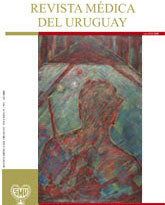Un caso grave de bullying
Rol del médico en atención primaria
Palabras clave:
ACOSO ESCOLAR, ATENCIÓN PRIMARIA DE SALUD, ROL DEL MÉDICOResumen
Se presenta un caso de exposición crónica a violencia psicológica y física entre pares en el ámbito escolar, que se diagnosticó a partir de una cruel agresión por parte de las compañeras de la paciente, que ocasionó heridas con lápices afilados en el rostro y desarrollo de daño estético y un trastorno de estrés postraumático. Este caso traduce una falla del sistema de salud en el primer nivel de atención en relación con la prevención, detección y abordaje de estas situaciones y nos lleva a plantear la necesidad de reflexionar sobre el tema e implementar estrategias de abordaje interinstitucionales centradas en la prevención, acorde al cambio de modelo de atención.
Citas
(2) Olweus D. Conductas de acoso y amenaza entre escolares. 2ª ed. Madrid: Alfaomega, Morata, 2004.
(3) Nansel TR, Overpeck M, Pilla RS, Ruan WJ, Simons-Morton B, Scheidt P. Bullying behaviors among US youth: prevalence and association with psychosocial adjustment. JAMA 2001; 285(16): 2094-100.
(4) Nansel TR, Overpeck MD, Haynie DL, Ruan WJ, Scheidt PC. Relationships between bullying and violence among US youth. Arch Pediatr Adolesc Med 2003; 157(4): 348-53.
(5) Lopes Neto AA. Bullying: comportamento agressivo entre estudantes. J Pediatr (Rio J) 2005; 81(5 Supl): S164-72.
(6) Cajigas de Segredo N, Kahan E, Luzardo M, Najson S, Ugo C, Zamalvide G. Agresión entre pares (bullying) en un centro educativo de Montevideo: estudio de las frecuencias de los estudiantes de mayor riesgo. Rev Med Urug 2006; 22(2): 143-51.
(7) Cajigas de Segredo N, Kahan E, Luzardo M, Najson S, Zamalvide G. Escala de agresión entre pares para adolescentes y principales resultados. Montevideo: UCUDAL, Facultad de Psicología, 2008. Disponible en: http://www.ucu.edu.uy/Facultades/Psicologia/TB/Documentos/accion_psico.pdf.(Consulta: 15/12/08).
(8) Trautmann A. Maltrato entre pares o "bullying". Una visión actual. Rev Chil Pediatr 2008; 79(1): 13-20.
(9) Juvonen J, Graham S, Schuster MA. Bullying among young adolescents: the strong, the weak, and the troubled. Pediatrics 2003; 112(6 Pt 1): 1231-7.
(10) Nansel TR, Craig W, Overpeck MD, Saluja G, Ruan WJ; Health Behaviour in School-aged Children Bullying Analyses Working Group. Cross-national consistency in the relationship between bullying behaviors and psychosocial adjustment. Arch Pediatr Adolesc Med 2004; 158(8): 730-6.
(11) Arseneault L, Walsh E, Trzesniewski K, Newcombe R, Caspi A, Moffitt TE. Bullying victimization uniquely contributes to adjustment problems in young children: a nationally representative cohort study. Pediatrics 2006; 118(1): 130-8.
(12) Rodríguez Piedra R, Seoane Lago A, Pedreira Massa JL. Niños contra niños: el bullying como trastorno emergente. An Pediatr (Barc) 2006; 64(2): 162-6.
(13) Fekkes M, Pijpers FI, Fredriks AM, Vogels T, Verloove-Vanhorick SP. Do bullied children get ill, or do ill children get bullied? A prospective cohort study on the relationship between bullying and health-related symptoms. Pediatrics 2006; 117(5): 1568-74.
(14) Kaltiala-Heino R, Rimpelä M, Marttunen M, Rimpelä A, Rantanen P. Bullying, depression and suicidal ideation in Finnish adolescents: school survey. BMJ 1999; 319(7206): 348-51.
(15) Asamblea General del Poder Legislativo. Código de la niñez y adolescencia. Montevideo: Iconoprint, 2005.
(16) Lyznicki JM, McCaffree MA, Robinowitz CB. Childhood bullying: implications for physicians. Am Fam Physician 2004; 70(9): 1723-8.
(17) Nickel MK, Krawczyk J, Nickel C, Forthuber P, Kettler C, Leiberich P, et al. Anger, interpersonal relationships, and health related quality of life in bullying boys who are treated with outpatient familiy therapy: a randomized, prospective, controlled trial with 1 year of follow up. Pediatrics 2005; 116(2): e247-54.
(18) Ohene SA, Ireland M, McNeely C, Borowsky IW. Parental expectations, physical punishment, and violence among adolescents who score positive on a psychosocial screening test in primary care. Pediatrics 2006; 117(2): 441-7.
(19) Borowsky IW, Mozayeny S, Stuenkel K, Ireland M. Effects of a primary care-based intervention on violent behavior and injury in children. Pediatrics 2004; 114(4): e392-9.
(20) Dake JA, Price JH, Telljohann SK. The nature and extent of bullying at school. J Sch Health 2003; 73(5): 173-80.
(21) Vreeman RC, Carroll AE. A systematic review of school-based interventions to prevent bullying. Arch Pediatr Adolesc Med 2007; 161(1): 78-88.












